 The four of us were highly amused by the directions painted on the tarmac. Adjusting to the driving patterns in Scotland has proved a slow-going process, so it was nice to have a little help in Ireland. The chirping crosswalk signals were also a nice touch.
The four of us were highly amused by the directions painted on the tarmac. Adjusting to the driving patterns in Scotland has proved a slow-going process, so it was nice to have a little help in Ireland. The chirping crosswalk signals were also a nice touch.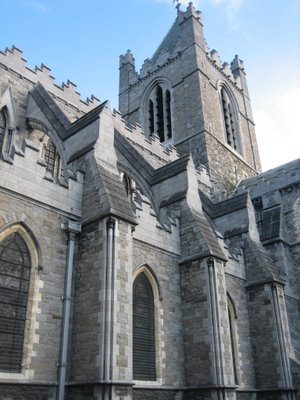 Our first stop--after purchasing toothpaste and deodorant, that is--was Christchurch Cathedral, the oldest building in Dublin. The ruins, outside of the restored nineteenth-century structure pictured above, date from the eleventh century CE.
Our first stop--after purchasing toothpaste and deodorant, that is--was Christchurch Cathedral, the oldest building in Dublin. The ruins, outside of the restored nineteenth-century structure pictured above, date from the eleventh century CE.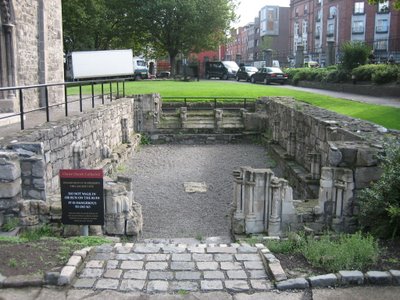 Here are the ruins of the original cathedral. The sign next to the entrance kindly asks you not to run on the ruins. It saddens me, but in no way surprises me, that the National Trust of Ireland feels the need to remind the average Joe not to horseplay on the remains of a ten-century-old religious structure.
Here are the ruins of the original cathedral. The sign next to the entrance kindly asks you not to run on the ruins. It saddens me, but in no way surprises me, that the National Trust of Ireland feels the need to remind the average Joe not to horseplay on the remains of a ten-century-old religious structure.After unanimously deciding we were all too cheap to pay the 5 Euro admission to Christchurch, we ambled along toward the city centre and dropped into City Hall, an imposing structure dating from the 1760s that formerly housed the Royal Exchange.
 A view of the columns in the rotunda. The floor of the entrance hall was a gorgeous marble mosaic featuring the seal of the city.
A view of the columns in the rotunda. The floor of the entrance hall was a gorgeous marble mosaic featuring the seal of the city.
The dome of the rotunda. (Why, yes, I did lie prostrate on the floor of City Hall to get this shot.) As I completely lack the mad photographic skillz of my paternal grandparents, my father, and my immensely talented sister, this photo is hardly symmetrical.
Our visit to City Hall was quite brief; we hadn't really planned on visiting, but it started to rain (Rain, in Ireland? Surely you jest!) and, wanting some shelter in which to ride out the storm, we ran to the first admission-free building we could find. Fortunately, the rain relented and we made our way to St. Patrick's Cathedral, the highlight of ancient Dublin (for me, at least).
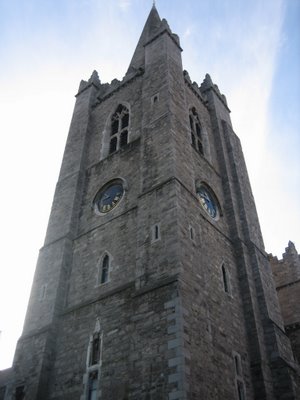
The bell tower of the cathedral. The original Celtic wooden church was raised to cathedral status in the twelfth century CE.
 The nave of the cathedral, looking toward the altar. Arranged around the pews are several barrister bookcases housing relics and artifacts. My favorites included the belongings of Jonathan Swift, a priest-cum-essayist, one of Ireland's most beloved literary figures, and perhaps the foremost satirist in the English language. Included among his personal effects were first edition prints of Gulliver's Travels and A Modest Proposal, his death mask, and a bronze cast of his skull.
The nave of the cathedral, looking toward the altar. Arranged around the pews are several barrister bookcases housing relics and artifacts. My favorites included the belongings of Jonathan Swift, a priest-cum-essayist, one of Ireland's most beloved literary figures, and perhaps the foremost satirist in the English language. Included among his personal effects were first edition prints of Gulliver's Travels and A Modest Proposal, his death mask, and a bronze cast of his skull.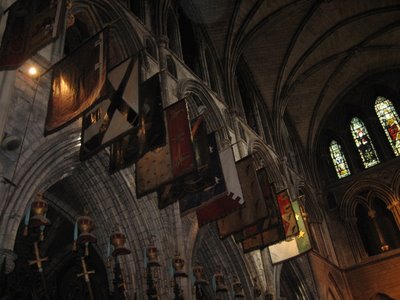 Flags hanging above the choir and a view of the vaulted ceiling.
Flags hanging above the choir and a view of the vaulted ceiling.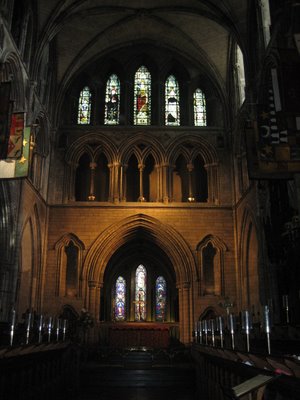 The cathedral's sanctuary.
The cathedral's sanctuary.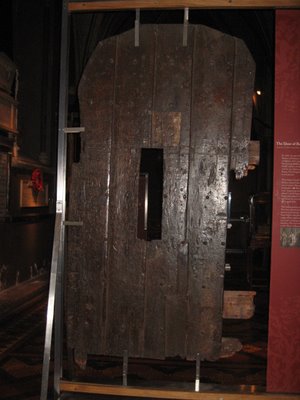 The Door of Reconciliation, located in one of the transepts of the cathedral. In 1492, two warring clans, the Butlers and the Fitzgeralds, struck a peace accord through this door. According to the story, Black James, a Butler on the run from Fitzgerald soldiers, sought sanctuary in St. Patrick's. Gearoid Ó“g Fitzgerald, the leader of the Fitzgerald troops, hoped to end the feud between the families, but each negotiation was refused by the Butler clan. Gearoid, in an act of profound bravery (or stupidity, however you see it) ordered his soldiers to cut a hole in the door, then thrust his arm through it, asking for a truce. Luckily, the Butlers did not slice off his vulnerable limb, instead agreeing to the accord. (This warm and fuzzy feeling of clan solidarity has been made possible by the National Trust of Ireland, Guinness Stout, and viewers like you.)
The Door of Reconciliation, located in one of the transepts of the cathedral. In 1492, two warring clans, the Butlers and the Fitzgeralds, struck a peace accord through this door. According to the story, Black James, a Butler on the run from Fitzgerald soldiers, sought sanctuary in St. Patrick's. Gearoid Ó“g Fitzgerald, the leader of the Fitzgerald troops, hoped to end the feud between the families, but each negotiation was refused by the Butler clan. Gearoid, in an act of profound bravery (or stupidity, however you see it) ordered his soldiers to cut a hole in the door, then thrust his arm through it, asking for a truce. Luckily, the Butlers did not slice off his vulnerable limb, instead agreeing to the accord. (This warm and fuzzy feeling of clan solidarity has been made possible by the National Trust of Ireland, Guinness Stout, and viewers like you.) The River Liffey as seen from O'Connell Bridge, named for Daniel O'Connell, The Liberator. A political leader in the nineteenth century, O'Connell helped spawn a wave of non-violent Irish nationalism and pushed for a repeal of the act of union tying Ireland to Great Britain. He is also featured in a statue just off the bridge.
The River Liffey as seen from O'Connell Bridge, named for Daniel O'Connell, The Liberator. A political leader in the nineteenth century, O'Connell helped spawn a wave of non-violent Irish nationalism and pushed for a repeal of the act of union tying Ireland to Great Britain. He is also featured in a statue just off the bridge. The front facade of Trinity College. We took a brief tour of the campus before entering the Book of Kells exhibit. Unfortunately, there was no photography allowed inside the exhibit, so I can show you neither the Book of Kells, nor the Long Room, the 65-meter long, barrel-vaulted library. I suppose you'll just have to go yourselves (which I fully recommend).
The front facade of Trinity College. We took a brief tour of the campus before entering the Book of Kells exhibit. Unfortunately, there was no photography allowed inside the exhibit, so I can show you neither the Book of Kells, nor the Long Room, the 65-meter long, barrel-vaulted library. I suppose you'll just have to go yourselves (which I fully recommend). A street artist outside of Trinity College who paints scenes on black tarpaulin.
A street artist outside of Trinity College who paints scenes on black tarpaulin. The Spire of Dublin, a sculpture erected in 2003. The Spire sits on the former site of the Nelson Pillar, which was blown up by the IRA in the late 1960s. Symbolizing progress or some such nonsense, the Spire, dubbed the 'Stiletto in the Ghetto' by the locals, was quite the controversial addition to the Dublin skyline. Honestly, I'm not sure how something that resembles a hypodermic needle is supposed to herald progress. Unless 'progress' is a new buzzword for 'heroin use.'
The Spire of Dublin, a sculpture erected in 2003. The Spire sits on the former site of the Nelson Pillar, which was blown up by the IRA in the late 1960s. Symbolizing progress or some such nonsense, the Spire, dubbed the 'Stiletto in the Ghetto' by the locals, was quite the controversial addition to the Dublin skyline. Honestly, I'm not sure how something that resembles a hypodermic needle is supposed to herald progress. Unless 'progress' is a new buzzword for 'heroin use.'Dublin has always been a religious city, originally Catholic, then Protestant, then returning to Catholic again. However, it seems there's a new kid on the block in Dublin, so the Christians had better watch out:
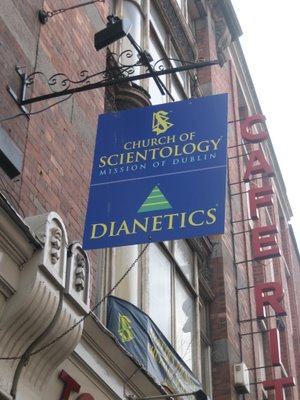 I'd like to apologize to the young man outside the Church of Scientology who sneered as I poked fun at his 'religion.' I'm sorry that you're ignorant enough to fall for the science fiction-turned-gospel of one L. Ron Hubbard. I'm sorry you feel the only way to enlightenment requires plunking down gobs of money and avoiding body thetans. I'm sorry South Park belittled your nutty cult--er, religion. Bunch of crackpots.
I'd like to apologize to the young man outside the Church of Scientology who sneered as I poked fun at his 'religion.' I'm sorry that you're ignorant enough to fall for the science fiction-turned-gospel of one L. Ron Hubbard. I'm sorry you feel the only way to enlightenment requires plunking down gobs of money and avoiding body thetans. I'm sorry South Park belittled your nutty cult--er, religion. Bunch of crackpots.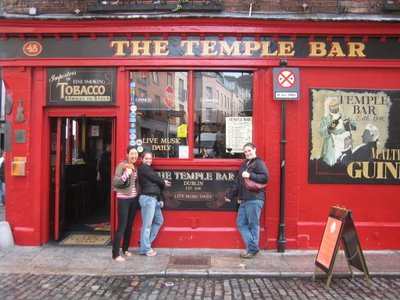 Having been inspired by our Xenu-loving friend earlier, we ladies decided to do a little worshipping ourselves at the Temple Bar. After receiving our communion from Sean the bartender (in the form of a Guinness Stout, no less), we celebrated Shae's 21st birthday, eventually making our way to a hotel bar that was featuring traditional Irish music and dancing. Below is a short clip of an a capella jig performed by the dance troupe.
Having been inspired by our Xenu-loving friend earlier, we ladies decided to do a little worshipping ourselves at the Temple Bar. After receiving our communion from Sean the bartender (in the form of a Guinness Stout, no less), we celebrated Shae's 21st birthday, eventually making our way to a hotel bar that was featuring traditional Irish music and dancing. Below is a short clip of an a capella jig performed by the dance troupe.We returned to Dublin Sunday afternoon and wandered around aimlessly, killing time until our flight back to Glasgow. Unfortunately, my camera decided it was in no mood to take any photos that day, so you have no lovely pictures of the National Museum of Ireland (complete with bog people!) or the woollen mill store where I spent the equivalent of a round-trip ticket from Glasgow to Athens on a wool blazer. In my defense, it's a gorgeous jacket (proof upon request).
Our final shot from Dublin was taken early Saturday morning as we walked to the city centre to catch our coach to Cork, near the southern coast. As sketchy as our hostel and its location had been, we were rewarded with this sunrise over St. Augustine Catholic Church. As I've said before, everything is prettier in a foreign country.


2 comments:
I think I've told you this before, but I am so freakin' jealous...
Tuscaloosa sucks...except for going out with Brandon, Peter, and some other boys...(I'll have to tell you about that later...)
Mom's feeling better.
Brett and Kristi's 5 year anniversary is on Saturday (They are going to an Ani concert in NO)
I'm leaving on Friday with Brandon and a friend from gradeschool to go to Knoxville--yeah, we're going to get beat (hence the reason why I bought a shit ton of minis to sneak into the game--how else will I be able to be around 90,000+ obnoxious UT fans???)
I love you!!!
Your pics are awesome...so is the narrarating :) Miss you!
Post a Comment